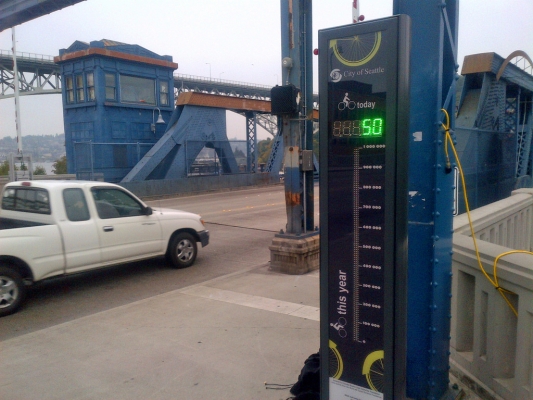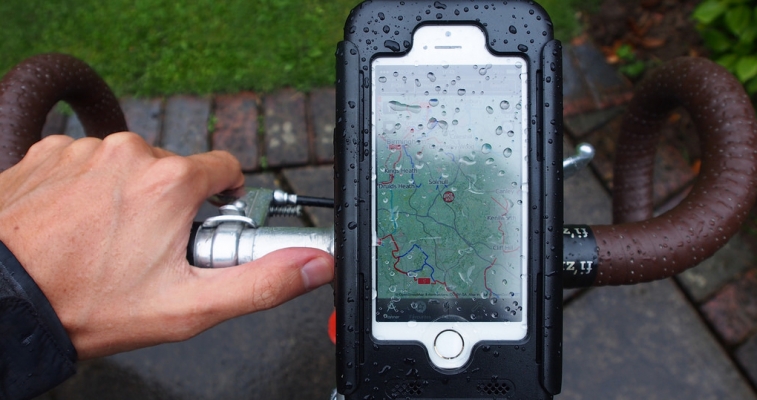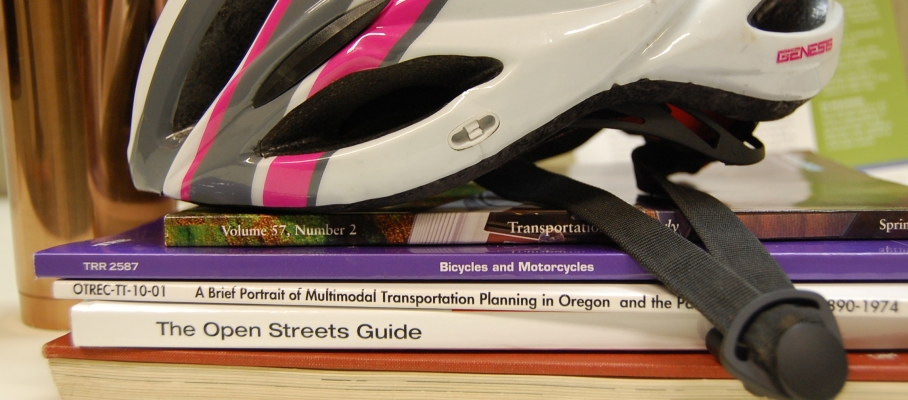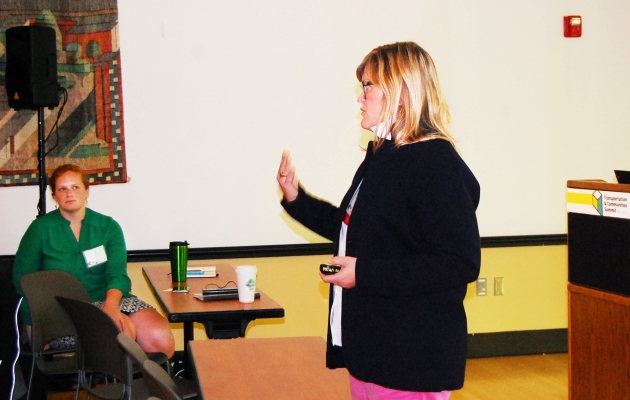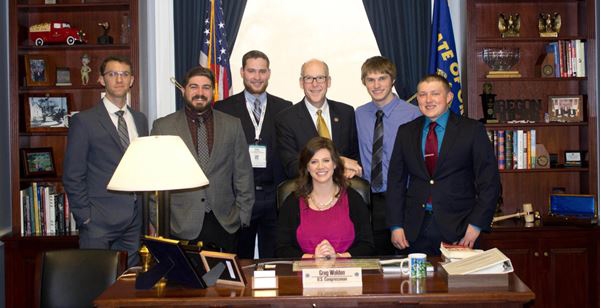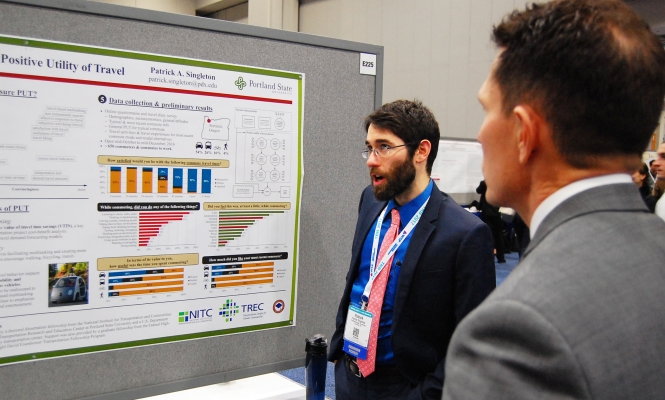Vehicle miles traveled, or VMT, is a standard indicator of how many vehicles use a roadway system. A similar metric for bicycles and pedestrians is needed in order to achieve livability goals. Such data can inform decision-making, facility design and planning, and safety analysis.
A NITC report from Portland State University evaluates three methods of calculating bicycle miles traveled (BMT) and pedestrian miles traveled (PMT) by applying them to Washington State.
The Washington State Pedestrian and Bicycle Miles Traveled Project was led by Krista Nordback, a former TREC research associate who is now a senior research associate at the University of North Carolina's Highway Safety Research Center.
The researchers used data from permanent counters when available; otherwise they used short-duration counts to extrapolate average annual daily bicycle and pedestrian traffic.
When the project began in 2012, only one permanent count site existed in Washington, and it only counted bicycles. Nordback’s team contacted state officials to advise that more counters would be helpful; the state listened and installed more counters. Now there are more than a dozen permanent bicycle and pedestrian counters scattered throughout Washington.
Nordback’s team investigated a survey-based method, a sample-based method, and an aggregate demand model...
Read moreTREC’s NITC program has made $500,000 available for grants to eligible researchers through its 2017 general research request for proposals. The RFP is the first since the NITC program expanded to include the University of Arizona and University of Texas at Arlington.
All proposals must contribute to the NITC theme, improving mobility of people and goods to build strong communities, and focus on transportation. They must also show strong potential to move transportation research into practice, inform other researchers, shape national and international conversations on transportation research, and respond to the needs of practitioners and policymakers.
Projects are capped at $100,000, and we encourage PIs to propose smaller projects. Priority is given to projects that are collaborative, multi-disciplinary, multi-campus and support the development of untenured tenure-track transportation faculty.
Key Dates
- Abstracts due: April 14, 2017
- Proposal due: May 15, 2017
- Peer reviews: June 2017
- Project Selection, Awards, and Task Orders: July-August 2017
- Projects begin: Sept 2017
Eligibility
Only eligible faculty members and research faculty from Portland State University, University of Oregon, Oregon Institute of Technology, University of Utah, University of...
Read moreA new NITC report from the University of South Florida makes it easier than ever for cities to collect useful bike data.
Cities like Portland, Oregon, Atlanta and San Francisco have started using smartphone apps to learn how people are using their bicycle infrastructure. The data can help planners decide what designs or upgrades are needed for the bicycle network.
The NITC project Rapidly Expanding Mobile Apps for Crowd-sourcing Bike Data to New Cities takes this idea a step further by creating a proof-of-concept multi-region architecture that would allow cities to share the same set of mobile apps, rather than each city launching its own.
This would significantly reduce the cost of deploying the apps.
Sean Barbeau of USF’s Center for Urban Transportation Research (CUTR) led the team in developing the open-source software that allows existing apps to communicate with regional servers.
With it, rather than each city having to modify and deploy their own iOS or Android app, all that a city would need to do is set up a server specific to their geographic area.
Having...
Read moreA NITC education project offers a new curriculum in multimodal transportation planning for graduate courses.
The development of this curriculum, along with a freshly minted course in multimodal transportation, allowed the University of South Florida (USF) to begin offering a graduate certificate in sustainable transportation for the first time in the spring of 2016.
The certificate program is multi-disciplinary and draws students from various fields including planning, engineering and public administration.
These educational efforts are designed to meet the needs of a growing field. Multimodal planning—planning for walking, cycling and transit in addition to auto travel—is becoming increasingly prioritized as communities across the U.S. redefine their planning practices.
As with any fast-developing discipline, the state of the practice sometimes outpaces existing courses and training materials.
Led by Kristine Williams, the USF Center for Urban Transportation Research (CUTR) developed a set of training modules that can be used in university settings and also to help planners in the field stay on top of the latest developments.
“There are pieces of multimodal planning in different courses, but the state of the practice has really changed a lot. We wanted to develop a...
Read moreThe city of Portland is using research and expertise from TREC researchers to change how it calculates fees for new development. Developers pay the fees, called transportation system development charges, to offset some of the costs of providing transportation infrastructure.
The foundation for those fees has been cars: that is, how many car trips a development will generate. In December, the Portland City Council voted to instead use “person trips” as the basis for those fees.
Researchers Kelly Clifton and Kristina Currans have assembled an impressive portfolio of research projects on trip generation. Their research caught the attention of city officials, who brought Clifton and Currans in as consultants to help them rethink the way they assess new fees for development.
Their work found a receptive audience of practitioners at TREC’s flagship conference, the Transportation and Communities Summit, last fall. Clifton and Currans held a workshop on improving trip generation methods to better represent the mix of modes found in livable communities. That led to a collaboration with transportation consultants...
Evaluation of Electric Bike Use at Three Kaiser Permanente NW Employment Centers in Portland Metro Region
John MacArthur, Portland State University; Jennifer Dill, Portland State University
Despite efforts to get more people biking, North America still has low ridership numbers. The problem? Biking is hard.
A new report by John MacArthur of Portland State University's Transportation Research and Education Center (TREC), funded by the National Institute for Transportation and Communtiies, offers a solution to that problem: e-bikes.
Many people surveyed say that having to pedal up hills and arriving at their destination sweaty are major deterrents to commuting by bike, even when bike lanes and other facilities are there.
Researchers have put a lot of thought into ways to get more people riding bicycles by improving bicycle infrastructure, land use and public engagement. The efforts are largely due to concerns about congestion, climate change and public health. Comparatively little research, however, has focused on the bicycle itself.
MacArthur and co-investigator...
Read moreA new NITC report offers a multimodal framework for transportation impact analysis – a welcome tool for professionals in many cities seeking more detailed data about non-drivers.
Improving Trip Generation Methods for Livable Communities, a research project headed by Kelly Clifton of Portland State University and Nico Larco of the University of Oregon, is the latest effort in an ongoing collaboration to create more open sourced, widely available data about non-motorized road users.
Over the last decades, cities have become more invested in fostering the conditions to support walking, biking and public transit.
The land development process presents a unique challenge.
Prior to a zoning change or new development, someone has to determine what its impact on the transportation system will be, and whether upgrades will be necessary to accommodate travelers to the new destination. Trip generation is the first step in the conventional transportation forecasting process.
Current trip generation methods used by engineers across the country tend to focus on motorized modes.
Without reliable trip generation rates for anyone but drivers, the transportation impact is difficult to predict. Certain land uses will draw far more walkers,...
Read moreGlobal heating caused by human activity is increasingly recognized as a threat to life on earth.
Despite the lack of a comprehensive national response to this threat, several states have already taken ambitious measures to combat the climate emergency.
A new NITC report examines the approaches used in four leading states—California, Maryland, Oregon and Washington—to identify strengths and weaknesses of the transportation-land use-climate policy framework in each state, and to find opportunities for improvement.
Rebecca Lewis and Rob Zako of the University of Oregon just released their report, Assessing State Efforts to Integrate Transportation, Land Use and Climate.
“States have been seen as laboratories of democracy, where we ground-test the ideas that might later apply at the federal level. States should be looking to learn from each other,” Lewis said. “States and cities are the ones taking action.”
The four states examined in this report are progressive in adopting state-level legislation to reduce emissions of greenhouse gases (GHG) from transportation.
Since the transportation sector accounts for almost one-third of all GHG emissions in the United States, transportation planners and policymakers have the ability to take...
Read moreSix students in the Institute of Transportation Engineers (ITE) Student Chapter of the Oregon Institute of Technology had an in-person meeting earlier this month with Congressman Greg Walden, Representative of the 2nd District of Oregon.
The students, along with Faculty Advisor Dr. Roger Lindgren, were in Washington DC attending the 2017 Transportation Research Board (TRB) Annual Meeting. Funding for the student travel was provided by NITC.
Students Andrew Wixon, Alex Antonaras, Ryan Kelly, Kevin Baker, Jason Millar and Jordan Preston had the opportunity for a brief conversation with the congressman as part of their TRB experience. Students at Oregon Tech have a strong tradition of participating in NITC projects and events.
Oregon Tech has partnered with the university transportation center at Portland State since its 2006 inception as OTREC, and continues this collaboration by being a part of the expanded NITC program grant established in 2016.
The ITE student chapter at Oregon Tech, since its establishment in 2002, has provided its student members with a variety of transportation learning activities including field tours, webinars, traffic bowl participation and travel to conferences.
One of the group's main priorities is putting engineering students in contact with practicing engineers and real-world projects...
Read morePortland State doctoral student Patrick Singleton won the best presentation award for the Doctoral Research in Transport Modeling and Traveler Behavior session of the Transportation Research Board annual meeting in Washington, D.C. This marks the second year running that a Portland State student has won the award, after Steven Gehrke won in 2016.
Singleton presented “Exploring the Positive Utility of Travel and Mode Choice,” drawn from his dissertation research. Positive utility of travel is a concept that travel can provide benefits and be motivated by factors beyond reaching a destination.
The award will be formally presented during the Network Modeling Committee meeting at next year’s Transportation Research Board conference.
Singleton continues to rack up awards. He has been named the NITC university transportation center student of the year and has received Eno and Eisenhower fellowships, being named the top-ranked Eisenhower recipient at the 2015 TRB annual meeting. He was also named a NITC dissertation fellow in 2016.
He is a doctoral student in the Civil and Environmental Engineering department and is involved in several TREC research projects. His adviser is Prof....

